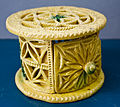Warmer
A warmer , or more rarely a stovchen , is a saucer on which a coffee or teapot is placed to keep the drink warm. As a rule, it is made of porcelain, wood or metal and is high enough to be able to place a heat source, for example a tea light under or inside. There are also cup warmer that are smaller than normal warmer and that keep a - usually matching - cup warm. Fragrance warmers , on the other hand, are used to release essential oils.
history
Rechaud-like bowls for glowing peat or charcoal pieces , which were kept ready for lighting pipes in sociable groups of men, were often made of clay in the 17th century, and in the 18th century they were also occasionally made of clay, known as "Rauch-Comfort" Silver. From the time around 1700 a " comfortje " as a tripod on which spiced wine could be quickly warmed up has been handed down in literature in Bremen . In the late 18th and 19th centuries it became customary that on occasions when tea was drunk in company, the drink was available for the guests in a tea machine , a Dröppelminna or crane jug on the table , or even just hot water, to dilute the tea, which is often served as a concentrate. They were often shaped so that a small burner could be pushed underneath.
In addition, around 1800 cylindrical, openwork teapots made of sheet metal ("tea comforts") became modern as a base for the tea or coffee pot, in which a charcoal bowl was inserted. They were available as small table utensils, often made of ornate openwork brass, or as larger round stoves that stood on the floor.
Etymology and conceptual delimitation
The word is a diminutive of Low German Stove with the meaning "heatable room, kiln , or Kieke ". This corresponds to standard German parlor . The English stove means "oven, stove". A historical device that works in a similar way is the wooden, box-shaped Feuerkieke of slightly larger format, which is heated with charcoal and placed on the floor so that the women could put their feet on it to warm. However, "Stövchen" and "Kieke" were not and are not kept strictly linguistically and functionally at all times and everywhere.
The rechaud, on the other hand, is a purely table-top device, formerly powered by coal, today powered by liquid fuel and intended more for food than for drinks.
- selection
Silver teapot (around 1780), Residence Museum in Celle Castle
Warmer from Veli Iž , Croatia
Rural fire kieke
Individual evidence
- ↑ Warmer. Duden.de, accessed on December 29, 2012 .
- ↑ You can find them depicted on numerous Dutch still lifes of the time.
- ↑ Alfred Löhr: Bremer Silber, Bremen 1981, pp. 88–90.
- ↑ Schenker, Konvoischiff, in: Bremisches Jahrbuch, Vol. 31, p. 271.
- ^ To the whole section: Christian L. Küster : Tea preparation, hot water devices , in: Tea. Cultural history of a drink . Exhibition catalog Altonaer Museum, Hamburg 1977, pp. 33–34 and cat. No. 215–221.
- ↑ Stove. In: Jacob Grimm , Wilhelm Grimm (Hrsg.): German dictionary . tape 19 : Stob – Strollen - (X, 3rd division). S. Hirzel, Leipzig 1957, Sp. 588 ( woerterbuchnetz.de ).
- ↑ room. In: Jacob Grimm , Wilhelm Grimm (Hrsg.): German dictionary . tape 20 : Strom – Szische - (X, 4th section). S. Hirzel, Leipzig 1942, Sp. 157–166 ( woerterbuchnetz.de ).




